another duplicate.
Follow the money trail. Perhaps the ICC did what they did because the young trucking industry had more pull? Just a thought.
Business regulation often has a political component. It’s possible that there still was a strong public antipathy to railroads as businesses that influenced that 1931 decision regarding containers.
The paper referenced below asserts that the ICC’s goal was to protect the weaker railroads from ruin - who protested the PRR’s usage of containers in that instance - and “save” the health of the entire railroad industry, regardless of the loss of efficiency by one carrier. See just the summary/ abstract on the top half of the 1st page to see that for yourself. - PDN.
[quote user=“Paul_D_North_Jr”]
greyhounds, thanks for those histories above - both Merchant Shippers’ and yours - and those insights. I expect that you’re aware of the paper I’ll cite and link to below, but others may not be, and may be interested in seeing it - it’s only 16 pages (approx. 95 KB in size), and not too tough of a read. A big thanks to Mike/ wanswheel for finding and posting at the current end of the thread here at the bottom of page 2 of 2 on “Question about Gondola Load” at: http://cs.trains.com/TRCCS/forums/t/156787.aspx?PageIndex=2
“Saving the Railroad Industry to Death: The Interstate Commerce Commission, the Pennsylvania Railroad, and the Unfulfilled Promise of Rail-Truck Cooperation” by Albert Churella, Assoc. Prof. in Social and International Studies at Southern Polytechnic State University, as published by the Business History Conference in “Business and Economic History On-Line”, Vol. 4, 2006, at:
http://www.h-net.org/~business/bhcweb/publications/BEHonline/2006/churella.pdf
and/ or,
Business regulation ALWAYS has a political component. If it didn’t it would not be regulated.
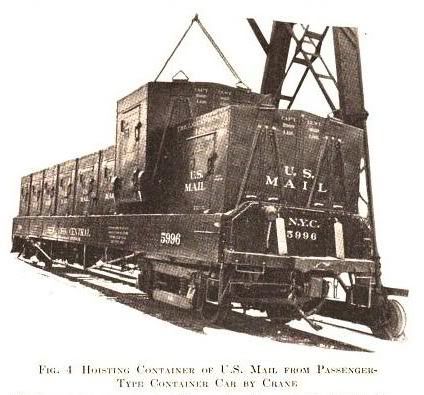

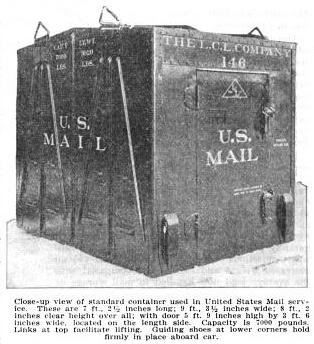
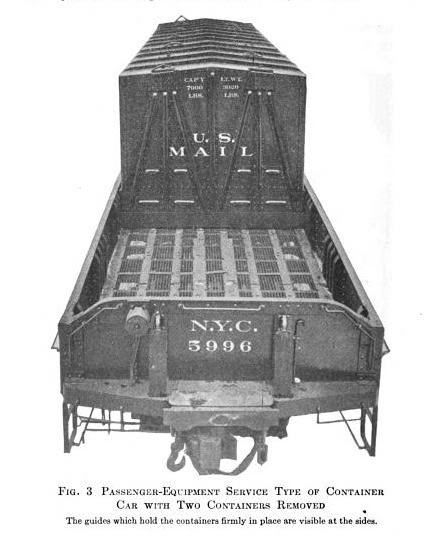
BURGLAR-PROOF CARS PUT IN MAIL SERVICE
The New York Times, Jan. 21, 1922
http://query.nytimes.com/mem/archive-free/pdf?res=F00716FD3A541B7A93C3AB178AD85F468285F9
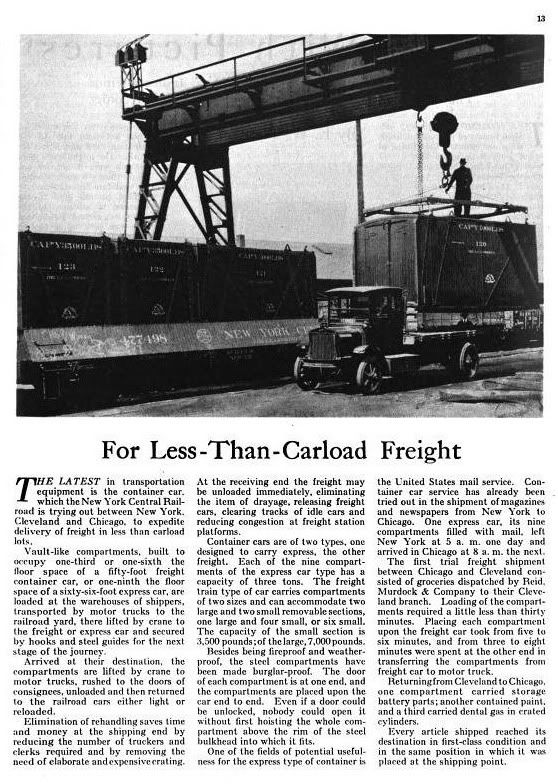
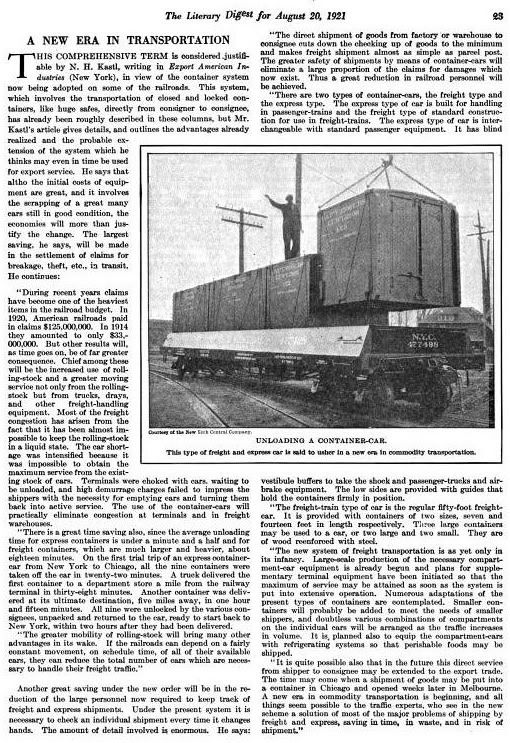
Even in the 50’s and 60’s there were those who believed the evil rail barrons of the late 19th and early 20th Century were still at the helm raping industry and farmers of their hard earned profits. And they were being fed the propaganda of the highway/oil lobby that King Rail was evil, that the only real way for an American to be free was to have a go at the open road be it to haul his family wherever they wanted to go or raw materials and manufactured goods where it needed to be.
[quote user=“Paul_D_North_Jr”]
The paper referenced below asserts that the ICC’s goal was to protect the weaker railroads from ruin - who protested the PRR’s usage of containers in that instance - and “save” the health of the entire railroad industry, regardless of the loss of efficiency by one carrier. See just the summary/ abstract on the top half of the 1st page to see that for yourself. - PDN.
Paul_D_North_Jr:
greyhounds, thanks for those histories above - both Merchant Shippers’ and yours - and those insights. I expect that you’re aware of the paper I’ll cite and link to below, but others may not be, and may be interested in seeing it - it’s only 16 pages (approx. 95 KB in size), and not too tough of a read. A big thanks to Mike/ wanswheel for finding and posting at the current end of the thread here at the bottom of page 2 of 2 on “Question about Gondola Load” at: http://cs.trains.com/TRCCS/forums/t/156787.aspx?PageIndex=2“Saving the Railroad Industry to Death: The Interstate Commerce Commission, the Pennsylvania Railroad, and the Unfulfilled Promise of Rail-Truck Cooperation” by Albert Churella, Assoc. Prof. in Social and International Studies at Southern Polytechnic State University, as published by the Business History Conference in “Business and Economic History On-Line”, Vol. 4, 2006, at:
Speaking of the Erie, their New York freight house was just a couple blocks from the New York Central. Here are links to pictures about construction of the High Line. In each photo there is an incidental glimpse of my favorite container car crane,
http://farm4.static.flickr.com/3074/3251450708_e01a87f781_b.jpg?rand=144355463
http://farm4.static.flickr.com/3535/3250627159_c3c147a69d_b.jpg?rand=125673791
http://farm4.static.flickr.com/3373/3251453372_13d03edb61_b.jpg?rand=692970177
http://farm4.static.flickr.com/3258/3251453652_f937880f54_b.jpg?rand=92915794
GLAD THAT SOMEONE REMEMBERS THE FORWARDER WHO WERE VERY LARGE
BEFORE THE CROSS-COUNTRY TRUCKERS AND DEREGULATION
HENRY ALSO EX ACME FAST FRIGHT
FUSE-
Before this thread slips off into oblivion I’d like to publicly thank wanswheel for the photos and articles he added to the discussion. They well illustrated and documented how intermodal service was developing in the 1920’s. That’s about as soon as the motor truck became able to handle a decent amount of freight.
Look at that photo above the article “For Less-Than-Carload Freight” A container being lifted between road and rail in the early 1920’s. Oh well, it’s another case of what might have been. Heck fire, they were even using a spreader bar and four corner posts on the container.
A train and a truck are but tools to do the same job. Which tool should be used depends on the situation. Combining the tools for use on the same job of moving a lot of goods from point A to point B is often more efficient than using just one of the tools for the whole job.
The railroads (at least some of them) understood that in the 1920’s. Unfortunately the government czars didn’t.
Stop trying to rationalize our country’s transportation system, greyhounds, it is unAmerican to do so.
Definitely more labor intensive.
One downside of container service was that it favored shipments that could fill a container, whereas LCL shipments could be as small as a child’s bicycle. That would mean that towns and cities with enough traffic to fill containers would be getting cheaper rates than smaller towns and thus could be considered as discriminating against small towns. This is similar to how the Southern Railway had to fight the ICC over rates for the “Big John” hopper car. Also remember that this was just a few years before the SCOTUS ruling on Wickard v Filburn with respect to the Interstate Commerce clause.
Please bear in mind that the previous paragraph is why I think the ICC ruled the way they did, but not emphatically not because I’m in agreement with the ICC ruling. I’m in complete agreement with you in that the US would have been much better off had container rates been allowed to reflect the lower cost of service.
- Erik
[2c] Just a few comments about Less than carload/truckload shipments.
In the truck business there are a whole bunch of LTL carriers in addition there are whole bunch of consolidators. The later gets shipments headed more or less in the same general direction and consolidates. Some of these will have deliveries to receivers and some to depots or warehouses for delivery by a third party.
In my end of the business(I drive a refridgerated truck) there are 4 or 5 LTL truck load carriers who do both LTL & consolidation. In addition there a mulittude of consolidators. To steal a quote from Star Trek Infinite Diversity in Infinite Combinations. (or something like that)
Also a little history, Purolater Air was bought by Emery in the late 1980’s , Emery in turn was bought by Consolidated Freightways(currently CF) to be merged with there CFAir division. Emery/CF Air is still in the Air Freight Forwarding business I believe.
Also in the same time period Federal Express bought Flying Tigers (late 1980’s) primarily to get better access to the Far East. That purchase got Federal Express past Japan in the Far East. They got a lot more as well. Federal Express was the 1st company in the overnite business nationwide. And Fred Smith only got a B- for the college paper describing the concept.
If I remember correctly, Federal Express started out with the authority of REA’s messenger/ courier authority. purchased out of bankrupcy court. FedEx started out with Falcon 20’s for aircraft the reason was that it had the right cargo capacity(4000lbs more or less) (in addition to financial support). There was a little looph
I think if PRR and NYC had had more business acumin, they would have set up a freight forwarding comopany, selling stock to make it independent, which would have owned the containers and possibly the specialized flatcars, established a wilingness to work with all railroads, and overcome the ICC objections. So it was not only the ICC’s fault, but also cold feet of the railroads involved.
I can see why it’s your favorite - those guys would recognize its progeny all over the US today ! What was it - 60 - 70 years until they came back in force ?
+1
Well said. Too bad that’s too complicated - or different, or threatening, etc. - for some people and institutions to comprehend
Thank you Greyhounds. Thank you Paul.
The award for Best Picture of a container car goes to…
http://www.canadasouthern.com/caso/images/nyc-5996.jpg
The earliest patent application date: June 9, 1920
http://www.google.com/patents?pg=PA1&zoom=4&id=Nb1TAAAAEBAJ#v=onepage&q&f=true
Alfred H. Smith, President of the New York Central Lines and one of the best known railroad men in the United States, was killed late yesterday afternoon when he was thrown from his horse in Central Park. Mr. Smith met his death in pulling up suddenly to avoid running into a woman, mounted on a horse, who had ridden across his path. (NY Times, March 9, 1924)
1924: Santa Fe steam train “Mrs. A. H. Smith’s Special” ran from Los Angeles to New York City, March 9-11, (via New York Central and Boston & Albany) 3,197 miles in 69 hours 7 minutes, average speed 46.3 miles per hour. (Chicago Daily News Almanac)
Alfred H. Smith Memorial Bridge
http://www.railpictures.net/viewphoto.php?id=194030
Mike
What appears to be forgotten in this discussion is the sfifling effect the ICC had on transportation competition and operation. Railroads were not allowed to own trucking or bus companies and vice versa. A manufacturer could not just call the railroad and say he had a boxcar load of widgets or considered he would have a boxcar load everyday and wanted a price quote or even a handful which had to be shipped daily. The railroad would have to have a tariff rate on file. So if the widget wasn’t on file in a tariff, the railroad would have to petition the ICC to set a rate; that petition was open for challenge and opposition by any other carrier be it rail, motor carraige, or air or water. This process took years in some cases. What started out as an agency to protect shippers from rate gouging by railroads became a bureau to prevent so called unfair competition by rate setting and not necessarily working for favor of the shipper. There were no long term contracts, no real competitive rate making or service provision: the tariff had to state the service and the price and was firm for both. So to say that any given railroad was short sighted in marketing is in error, that they didn’t market or turned thier backs on marketing is wrong. Simply put the ICC process was too encombering to be too innovative and often the guy with the already established cheaper rate stood in your way, so why bother, just keep on railroading (trucking?) the way you always have, there’s plenty of time for innovation in the future, Maybe.
Mike, you continue to amaze me . . . all great stuff . . . very interesting. Until this, I doubt if much of it had ever seen the light of day in the last 50 years or so - certainly I’ve not seen it or a reference to it before. Not only John Kneliling’s book, many columns and several articles, but George Hilton’s article in Trains on containerization*, David Deboer’s book, Ernest Robl’s reference website, “The Intermodal Container FAQ” at - http://www.robl.w1.com/Transport/intermod.htm - and his book, and some others I can’t think of right now or don’t yet know about - could have benefitted from access to this information.
*Integration in the north
How White Pass & Yukon, Alaska, and CN-Newfoundland interchange
by Hilton, George W.
from Trains July 1971 p. 36
ARR CNR&